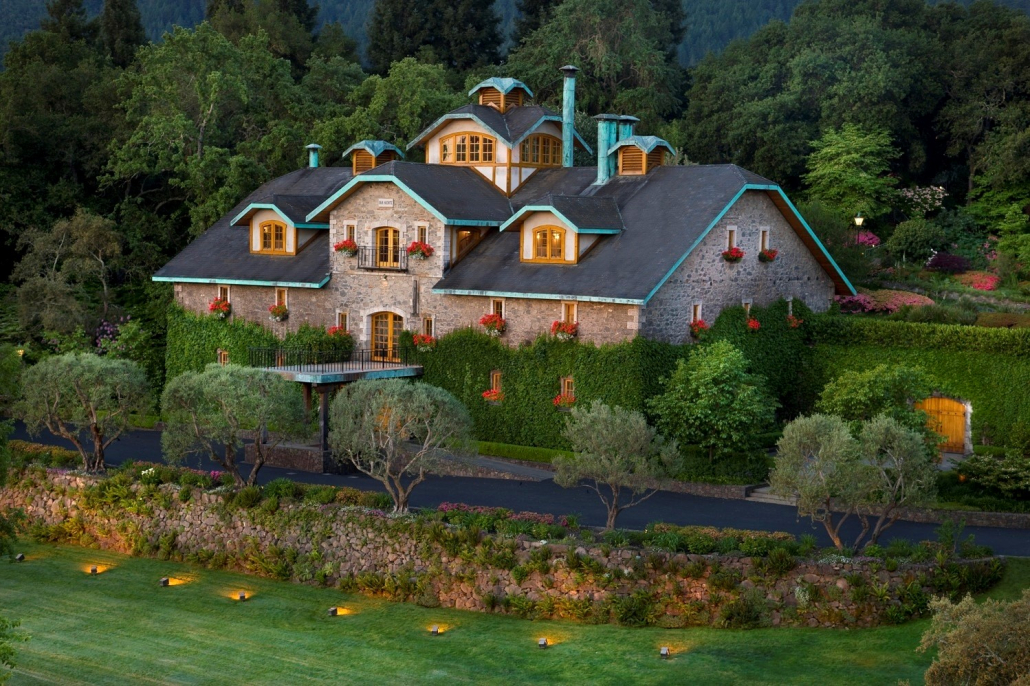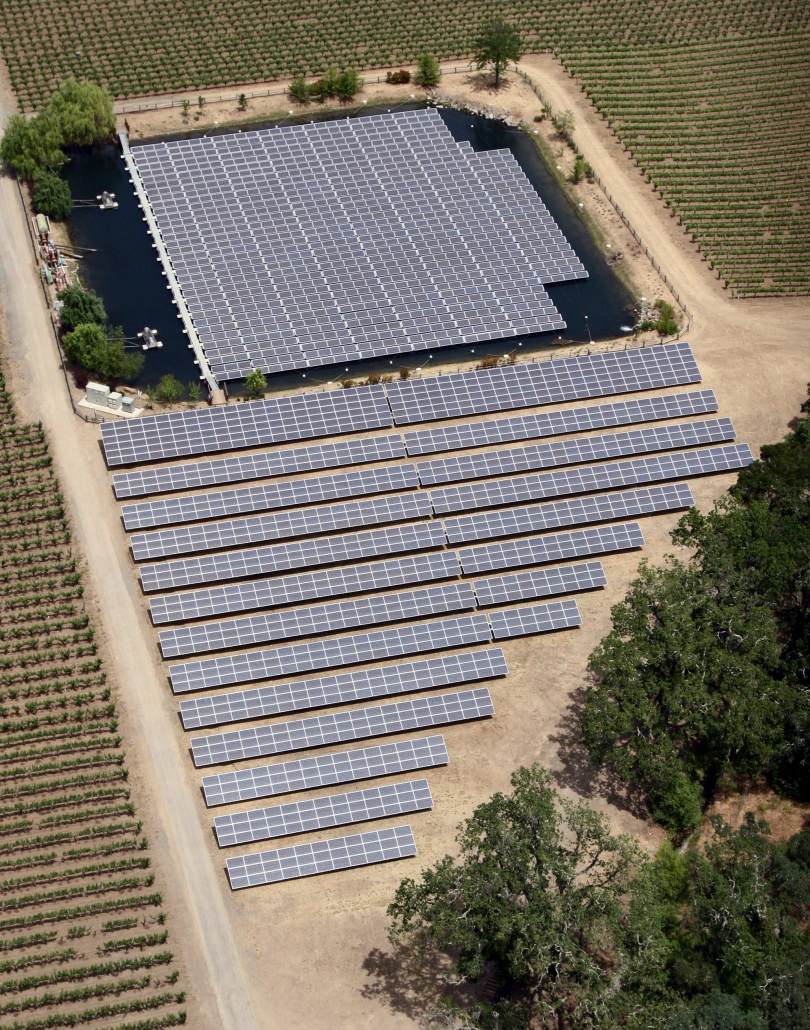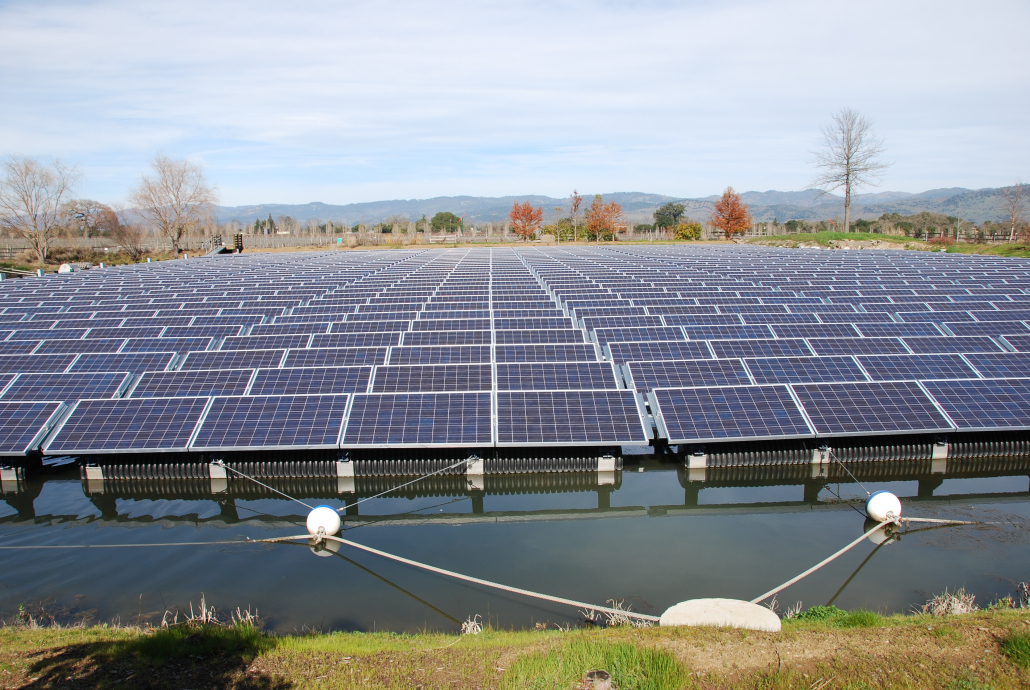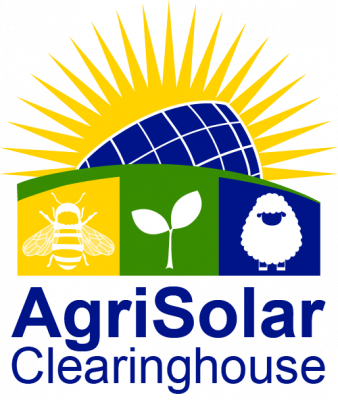Floating Solar Photovoltaic (FPV) deployment continues rapidly worldwide, outpacing under-standing of any concomitant environmental impacts. The findings in this study demonstrate that modelling, using an uncertainty framework, can provide useful insight into possible water body response. Specifically, this study found that FPV generally promotes cooler water temperatures that, coupled with deteriorated light conditions, slow phytoplankton growth. Results show that the location of an FPV on the water surface can significantly affect water body thermal dynamics, modifying phytoplankton response beyond the impacts of percentage coverage.
Tag Archive for: aquavoltaics
This study investigates the use of a foldable solar panel system equipped with a dynamic tracking algorithm for agrivoltaics system (AVS) applications. It aims to simultaneously meet the requirements for renewable energy and sustainable agriculture.
This work looks at a variety of other hybrid FPV energy sources with varying technology readiness levels. This paper concludes with the possibility of integrating different renewable technologies with existing FPVs and highlights the boons of doing so with some examples
The main objective of this work is to provide a comprehensive insight into this new technology, various research and developments that have been reported and potential future development. The critical review indicates that advancements in this technology shall focus on improved floating structure design, robust instrumentation, wireless monitoring, and sensing capabilities.
Colorado Governor Announces Agrivoltaic Funding
“Colorado governor Polis and Colorado Department of Agriculture (CDA) Commissioner Kate Greenberg awarded $500,000 in grants to seven projects that demonstrate the use and benefits of agrivoltaics, the simultaneous use of land for solar energy production and agriculture. These grants distributed by the Polis administration will provide funding to incorporate innovative technology that supports Colorado’s producers to operate in the face of challenges created by climate change and prepare the next generation.” – Colorado.gov
Sarah Bendok Receives Permit to Build Agrisolar Project in Phoenix
Sarah Bendok has received the permits by the city of Phoenix required to proceed with constructing a 5-KW agrivoltaic system. The project is expected to cost around $20,000 and is financed through donations from community events, presentations and grants. Sarah is the founder of the non-profit Growing Green, where they help local farmers develop, implement and fund sustainable technologies.
Learn more about Growing Green here.
Agrisolar Benefits Farmlands and Local Economies
“Smaller residential solar arrays, owned by the landowner, can significantly reduce the electricity bills of a farm, often covering the electricity needs of barns, warehouses, equipment, and the household.
Michigan State University found that a 10 kilowatt (kW) solar system could save the average farm about $1,880 per year. Other farms, like dairy farms, have a more energy intensive operation and the same 10 kW system could save a dairy farm nearly $4,000 per year. Combined with federal incentives and USDA rural energy programs, farms can save even more on upfront costs.
Lightsource bp’s Elm Branch and Briar Creek solar projects in Texas delivered two new revenue streams to local farmers. The first was in the form of lease payments. The second was a grazing contract for the farmers’ more than 1,000 sheep. These sheep now control the growth of grass on the site and stay cool under the shade of the panels.” – Cleantechnica
Agrisolar: The Key to a Clean Energy Future
“Interest in agrivoltaics is growing, along with the need for land for new solar farms, as Minnesota and the nation shift to cleaner energy. The U.S. Department of Energy estimates 10 million acres of solar panels will be needed by 2050 to meet the nation’s net zero-carbon goals.
US Solar owns the 1-megawatt Big Lake community solar garden and about 80 more in Minnesota. It’s part of a pilot project encouraging farmers to grow crops or graze livestock between and underneath solar arrays.” – MPR News
Oil Companies Lightsource and Shell Using Agrisolar
“Today, the U.S. has about five gigawatts of agrivoltaic projects, encompassing more than 35,000 acres across over 30 different states. While this only represents about 3% of the country’s installed solar capacity, it’s a growing industry, and farmers are taking note.
Lightsource operates a combined 615 megawatts of sheep grazing and solar power projects, around 12% of the nation’s entire agrivoltaic portfolio. The company plans to add an additional 1,058 megawatts worth of projects next year. Shell is also involved in the space through its 44% stake in solar developer Silicon Ranch. The ranch operates 1,300 megawatts of agrivoltaic projects with an additional 900 megawatts planned over the next two years.
While there are other players in the domestic agrivoltaic market such as Enel Green Power and US Solar, Lightsource and Silicon Ranch remain the largest players in the space. American oil majors such as Chevron and Exxon haven’t invested in agrivoltaics.” – CNBC
U.S. Senators Introduce Bipartisan Bill that Supports Agrivoltaics Research
“U.S. senators on both sides of the aisle have recently proposed two bills to boost agrivoltaics, the double-duty climate solution that pairs solar panels (photovoltaics) with agriculture — or closely related land uses that benefit farmers and ecosystems.
In May, senators Jeff Merkley (D-Oregon) and Cory Booker (D-New Jersey) introduced the Pollinator Power Act. Its passage would direct the U.S. Secretary of Agriculture to prioritize solar projects funded by the Rural Energy for America Program that create habitat for pollinators underneath the panels. Pollinators such as bees, butterflies and beetles are responsible for pollinating three-quarters of flowering plants and 35 percent of food crops, but populations are in striking decline, in major part because of habitat loss.
On the heels of the pollinator bill, senators Martin Heinrich (D-New Mexico) and Mike Braun (R-Indiana) worked across the aisle to jointly propose legislation that could catalyze the growth of agrivoltaics in the U.S.: the Agrivoltaics Research and Demonstration Act. If made law, the act would invest $15 million per year from 2024 to 2028 — $75 million total — toward agrivoltaics research and demonstration projects.” – Canary Media
“”Agrivoltaic systems within the legislation apply to lands where agricultural activities and solar energy production are simultaneously taking place. The USDA’s National Institutes of Food and Agriculture would work closely with the Department of Energy to establish a network of demonstration sites nationwide through the legislation. Agrivoltaic advocates note that the practice can increase farm profits through the reduction in energy use or selling of energy generated on-farm. Other supporters of the legislation include American Farmland Trust (AFT) and the National Sustainable Agriculture Coalition.” – AgNet West
Danish Agrisolar Project will Utilize Sheep Grazing
“Danish renewable energy company Eurowind Energy is developing an agrivoltaic project in Romania, a 70 MW photovoltaic park that will combine solar energy with agriculture. The solar park will span 80 hectares, with 119,184 modules, while its projected annual electricity output is about 102 GWh, enough to supply some 30,000 households.
At the same time, 130 farmers will be able to use the 80-hectare land for their animals to graze, according to media reports, which cited a press release from Eurowind Energy.
Recently, works were launched on Croatia’s first agrisolar power plant, in a project that will involve sheep farming. Earlier this year, Hungary-based BSD Invest Europe said it was planning to install a solar park with on the Serbian-Montenegrin border, which would simultaneously be used for sheep farming and growing berries.” – Balkan Green Energy News
Ohio Agrisolar Project Funded by State Agency
“The Madison Fields project is being developed by Savion Energy of Kansas City, Missouri, and is expected to be completed in December 2023 and plans to operate for at least 30 years. The company is working with Ohio State University’s Extension Service on pairing agriculture with solar.
The 180-MW solar facility is expected to generate the equivalent power for up to approximately 35,000 households. The project creates two full-time permanent jobs and 596 full-time temporary positions during the construction phase.
The company has received community support for the project including from the Board of Commissioners of Madison County, the Madison County Soil and Water Conservation District, Pike Township and Fairbanks Local School District.” – Solar Power World
In this paper, researchers quantify floating photovoltaic impacts on lake water temperature, energy budget and thermal stratification of a lake through measurements of near-surface lateral wind flow, irradiance, air and water temperatures at one of the largest commercial German facilities, situated on a 70 m deep dredging lake in the Upper Rhine Valley, South-West Germany.
This study focuses on the dual use of the water area at a small-scale shrimp farm in western Taiwan for solar photovoltaic electricity generation and aquaculture. Based on the simulation results and SWOT (strengths, weaknesses, opportunities, and threats) analysis, recommendations are made for the design and operation of a solar-powered aeration system for shrimp farms.

By Anna Adair, NCAT Energy Program Assistant
At Far Niente Winery, respecting the land and all it provides is just second nature. Since 1979, their winemakers have been coaxing award-winning wines out of the grapes grown on their Napa Valley estate, but in 2005 began embracing their role as environmental stewards through their sustainability practices related to farming, winemaking, and renewable energy generation. Located on the Martin Stelling Vineyard in Oakville, Far Niente’s floatovoltaic system is at the forefront of the winery’s commitment to those sustainable practices and ethical winemaking.
When Far Niente decided to go solar, they faced challenges both unique and common to the agricultural world. Where many businesses may have chosen to place panels on the roof of their buildings, Far Niente’s old stone winery building is on the National Register of Historic Places, making it impossible to do so without violating regulations. Installing ground-mounted panels immediately around the heritage building was not an appealing solution either. After doing the math and realizing they would need to install over 2,000 panels to hit their energy production goal, they were faced with a tough choice: remove established cabernet sauvignon vines or get creative and take a risk. “Taking two acres out of cabernet production really hurts,” says winemaker Greg Allen. “By looking to the pond, it allowed us to maximize how many grape vines we were able to keep and still meet our goal.” These challenges ultimately culminated in the decision to build the world’s first grid-connected floating solar array, despite the lack of real-world success stories of floatovoltaic arrays at the time.
Developed by Thompson Technology Industries and installed by SPG Solar, the ambitious project went live in April 2008. A total of 1,000 Sharp 208 polysilicon panels were installed over the vineyard’s pond, covering just shy of a full acre. The panels rest atop pontoons anchored to the pond’s banks via marine-grade cabling attached to concrete columns. This setup allows the pontoons to rise and fall with changing water levels throughout the year. Rounding out the vineyard’s solar system are 1,300 ground-mounted panels adjacent to the pond. The system was originally installed with a 500-kilowatt central inverter, but that was replaced after 10 years with 12 SolarEdge string inverters. Together at peak output, the arrays generate roughly 407 kilowatts total with about 177 kilowatts coming from the floatovoltaic system alone.

Unsurprisingly, building such a system comes with a substantial financial commitment. The project’s total cost was $4.2 million upon completion, with an estimated payback period of 12 to 15 years. Fortunately, the net cost for Far Niente was significantly less, thanks to a $2.80/kW self-generation cash rebate from Pacific Gas & Electric, as well as a 30% federal tax incentive and accelerated depreciation tax benefit. The winery worked with Banc of America Leasing and Capital on a seven- year lease as well, which included a buyout option that would allow them to be the sole owners of the system. Far Niente did opt to purchase the array at the end of the seven years, and reports that the system paid for itself at around year 14 of operation.
With all the energy generated by the system, the winery is able to cover about 80% of its annual energy requirements, but that is far from the only benefit. The floatovoltaic array saves almost a full acre of viable land from being sacrificed for additional ground-mounted panels. Since this part of the vineyard is foundational to the winery’s cabernet sauvignon program, all that preserved space equates to thousands of dollars of bottled cabernet sauvignon revenue saved each year.
Additionally, there’s reason to believe that the panels’ positioning on top of the pond leads to increased efficiency when compared to the ground-mounted panels. Greg Allen has taken the surface temperature of the panels and found that those on the floating array can measure up to 5 degrees Fahrenheit cooler than their land-based counterparts. Because photoelectric conversion improves in cooler environments, keeping the solar panels at a lower temperature will increase the energy production efficiency when compared to the warmer panels on land.
A further boon to resource management is the array’s potential to reduce evaporation rates — a crucial win for a vineyard operating in an area seeing increasingly higher temperatures and more frequent drought conditions. While Greg notes that there is no completed study yet, he says, “In my mind, I think that the panels decrease the amount of evaporative loss from the pond.” He adds that it is difficult for the winery to quantify the potential amount of water saved, since there are systems both pulling water from and pushing water to the pond at various times. Currently, the pond serves the winery in several capacities, including as a fire- and frost-protection system, irrigation source, and as the recipient of all process wastewater from the winemaking facility. Three wells intermittently feed the pond, as well. Greg states that there is an ongoing research partnership between the winery and University of California Davis that will hopefully shed light on the shading and water conservation benefits, as well as the ecological impacts of the array.
When reflecting on the challenges the project presented, Greg says “Interconnection [to the grid] was a big one.” In order to meet their energy production goals, the entire system needed a 500-kilowatt inverter. The winery hit a roadblock with the project when they realized the main service transformer for the winery was only half that size. Far Niente’s utility provider requires that the main service transformer must be able to accommodate 100% of the energy produced by a solar system. “That spawned a massive project of its own,” Greg says, since the winery then had to replace their transformer to match the power rating of the inverter before they could bring the array online.
As the system approaches 15 years of use, they are noticing more individual panel failures. Greg says that the panels installed in 2007 are no longer commercially available to replace the failed panels, but there is a silver lining. He estimates around five more years of operation with their current set up, and then the winery could begin to look at the possibility of a major system overhaul. Over a decade of research and development has greatly increased the efficiency of today’s panels, providing the possibility of cutting their solar array footprint in half while maintaining the amount of energy produced on-site. “We could regain substantial amounts of vineyards,” he says. Should the winery choose to overhaul their entire system in such a way, the future revenue from the potentially recovered vineyard space could fund the cost of the improved system.

Looking back, Greg says a big challenge has been on the operations and maintenance side of owning the arrays. “Our main job is making and selling wine, and suddenly we’re put in the position of having to – on a daily basis – verify that the system is functioning and then initiate troubleshooting” when it’s needed. He points out that in the beginning, no one at Far Niente was an expert at what essentially became running a small power plant, but they had to develop that expertise in order to keep the system operating. With the possibility of a new system installation on the horizon, Greg speculates that partnering with a third party on a power purchase agreement could be an ideal solution for Far Niente. A power purchase agreement is an arrangement that allows a solar developer to install, operate, and own a system on a customer’s land. The customer is then able to purchase the electricity generated by the system directly from the developer, often at reduced rates. “It means that we would have on-site generation of renewable energy that we use,” he says, “and we would rely on the experts to maintain the system while we focus on growing grapes and making phenomenal wine.”
No decisions have been made yet as to whether Far Niente will pursue upgrading their system or move towards a power purchase agreement. Regardless of what path the winery will take in the coming years, Greg says they are really pleased with their decision to pursue onsite renewable energy generation and the overall performance of the solar arrays over the years. In particular, the winery’s ownership and staff have enjoyed being pioneers in the field of floatovoltaics. Far Niente’s years of renewable energy generation serve as an excellent example of how solar energy production can support a company’s efforts to implement sustainable measures while existing in harmony with agricultural operations.
New Study Shows Broccoli as Ideal Crop for AgriSolar Farms
According to a new study by researchers of South Korea’s Chonnam National University, broccoli has shown to be an ideal crop to be grown under solar panels.
“As per the study, the shade offered by the solar panels helps the broccoli get a deeper shade of green, which makes it look more appealing and it does so without a major loss of crop size or nutritional value. However, financial benefits for farmers producing solar energy are considerably more compared to the income generated by growing broccoli — nearly ten times more. Essentially, farmers are missing out on an opportunity by not having solar panels installed on the field.” – IT Technology
Cattle Graze Under Solar Panels in Minnesota
Cattle grazing under solar panels along U.S. Highway 59 in Morris, Minnesota, are under the direction of Bradley Heins, Ph.D., University of Minnesota. The cattle use the panels for shade and shelter, while other aspects of the operation are being studied further, such as water-runoff usage, pollinator habitat, and various potential crops to be grown.
“Studying both the theoretical and the practical applications of agrivoltaics is James McCall, a researcher in mechanical engineering with the National Renewable Energy Laboratory (NREL). NREL is funded by the U.S. Department of Energy.
‘To achieve the current administration’s decarbonization goals, we are going to need 10.3 million acres of land (by 2050) to achieve a high decarbonization and electrification scenario,’ said McCall. ‘We see a lot of pushback from local communities who don’t really want these projects on their land or in their community, a solution that has popped up is agrivoltaics.’
It’s possible that agrivoltaics could help develop a more pastoral environment for communities, and additional revenue streams for developers and farmers.” – Farm Ranch Guide
U.S. Army Launches Floating Solar Farm
Last month, a ribbon cutting took place for a U.S. Army floating solar farm, sited on Big Muddy Lake at Camp Mackall on Fort Bragg, North Carolina.
“Fort Bragg is the largest military installation by population in the Army, with around 49,000 military personnel, 11,000 civilian employees, and 23,000 family members. The 1.1-megawatt (MW) floating solar farm includes 2 MW/2 megawatt-hour of battery energy storage.
The floating solar farm is a collaboration between Fort Bragg, utility Duke Energy, and Framingham, Massachusetts-based renewable energy company Ameresco. The U.S. Army’s announcement explains: This utility energy service contract project will provide carbon-free onsite generation, supplement power to the local grid, and provide backup power for Camp Mackall during electricity outages.
The U.S. Army has a goal of slashing its emissions 50% by 2030 and achieving net zero by 2050. It also wants to proactively consider the security implications of climate change in strategy, planning, acquisition, supply chain, and programming documents and processes.” – Electrek
